Tomato and Onion Chutney is a sweet and savory chutney recipe made with ripe tomatoes, herbs and spices. This is a quick and easy Indian fusion recipe, based on South Indian tomato chutney that is incredibly delicious and bursting with flavor. Use as a side dish for meat and fish or as a relish for burgers and more.
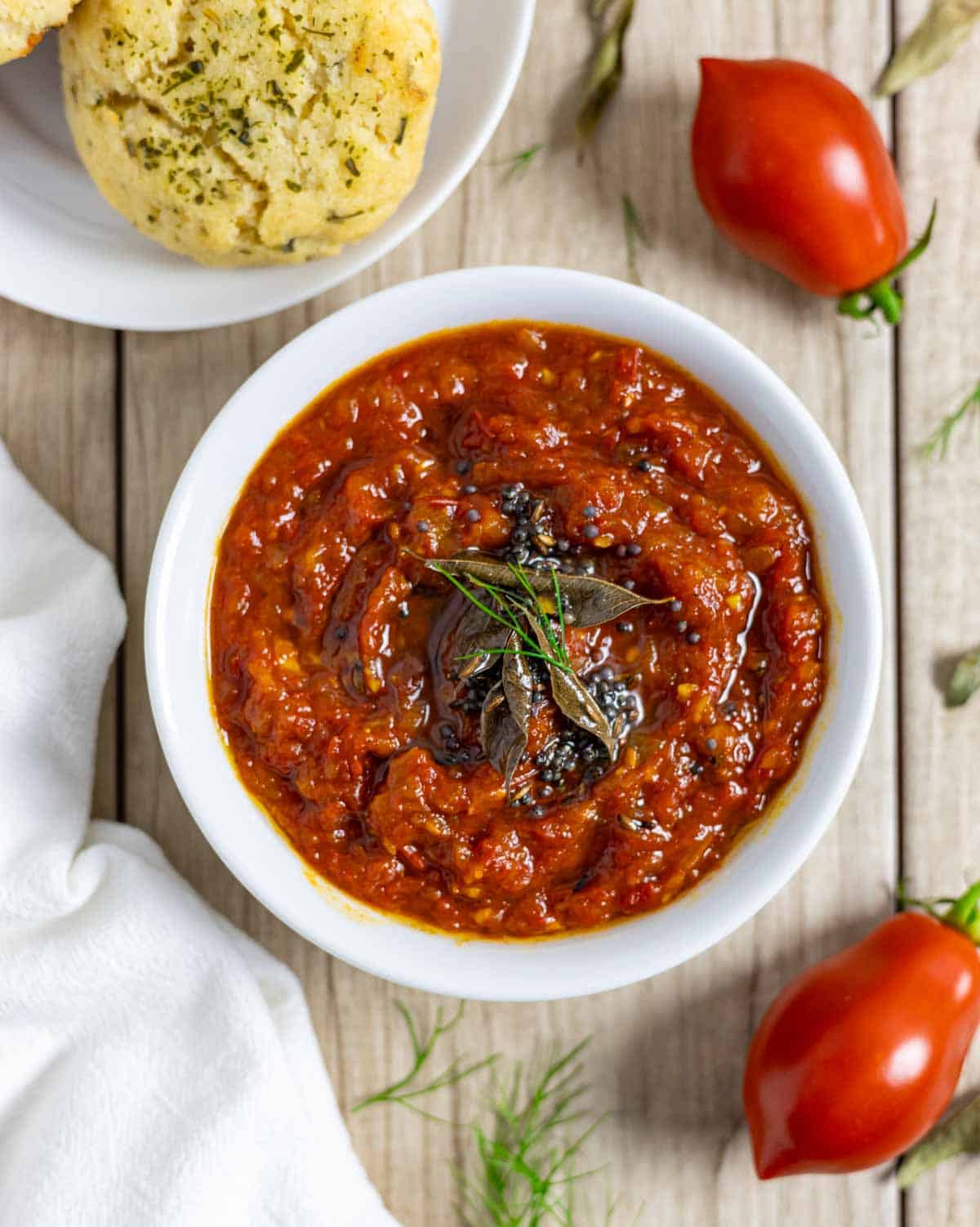
Jump to:
Tomato onion chutney is a very versatile condiment and side dish that pairs well with a great variety of foods including Indian Spiced Salmon and Cheddar Drop Biscuits. It’s very similar to my Tomato Chili Jam recipe, but incorporates more traditional Indian flavors and includes onion and garlic. This is a great way to use your summer tomato harvest or even consider making this as a savory Christmas jam. It’s also a unique recipe to make for holiday and Christmas gifting.
There are many variations of this recipe throughout India. Most recipes are made with dal, chilies, asafoetida, garlic and tamarind. However, I adjusted this recipe to keep it low carb and have eliminated the dal.
Traditionally, this is a tomato chutney for dosa (a thin savory pancake made from fermented rice and lentil batter) or for idli (a savory steamed rice cake) and is often served as a breakfast side dish. It’s blended and served with an herb infused oil (also known as tempering – see below). I typically don’t blend my chutney (I like it a little chunky), but I do love to add the tempering.
Why you’ll love this recipe
- Incredible flavor – the herbs, spices, onion and garlic create a truly sensational flavor
- Easy to make – it’s a simple recipe and is a great summer and fall tomato harvest recipe
- Versatile – you’ll want to put this on everything!
- Low-carb chutney – this version excludes the traditional chana or urad dal, which is high in carbs
- Special diet friendly – make this with your favorite alternative sweetener for a low-carb keto recipe. It’s also paleo and Whole30 compliant. It’s healthy, so delicious and made with whole foods.
What is chutney?
Chutney is a condiment that can be made from fruits or vegetables and can be savory or sweet. It originated in India as a way to preserve autumn harvests.
Consistency varies by country and can vary between regions in India. In the East, chutneys are often (and most traditionally) a smooth, thick puree. In America, they tend to contain large chunks of fruit and vegetables and have both savory and sweet notes.
Chutney vs relish
They both are very similar and the names are often used interchangeably. Both can be savory or sweet, but there are some differences that set them apart.
Relish is usually a sweet and sour condiment made from finely chopped fruit and vegetables. It also commonly contains vinegar that contributes to the sour tang.
In the U.S., chutney has a softer, thicker consistency than relish, often with chunks of fruit and vegetables. Eastern versions tend to be thick, pureed and spreadable.
Is this a low-FODMAP chutney?
You can make this a low-FODMAP chutney! According to the Monash app, there are FODMAP-friendly servings of onion. Simply reduce the amount used and consider using Vidalia onions, as they seem to be lower in fructans than other varieties.
Garlic is high in fructans in any serving size, so it should be replaced by garlic infused olive oil or garlic scapes, as tolerated.
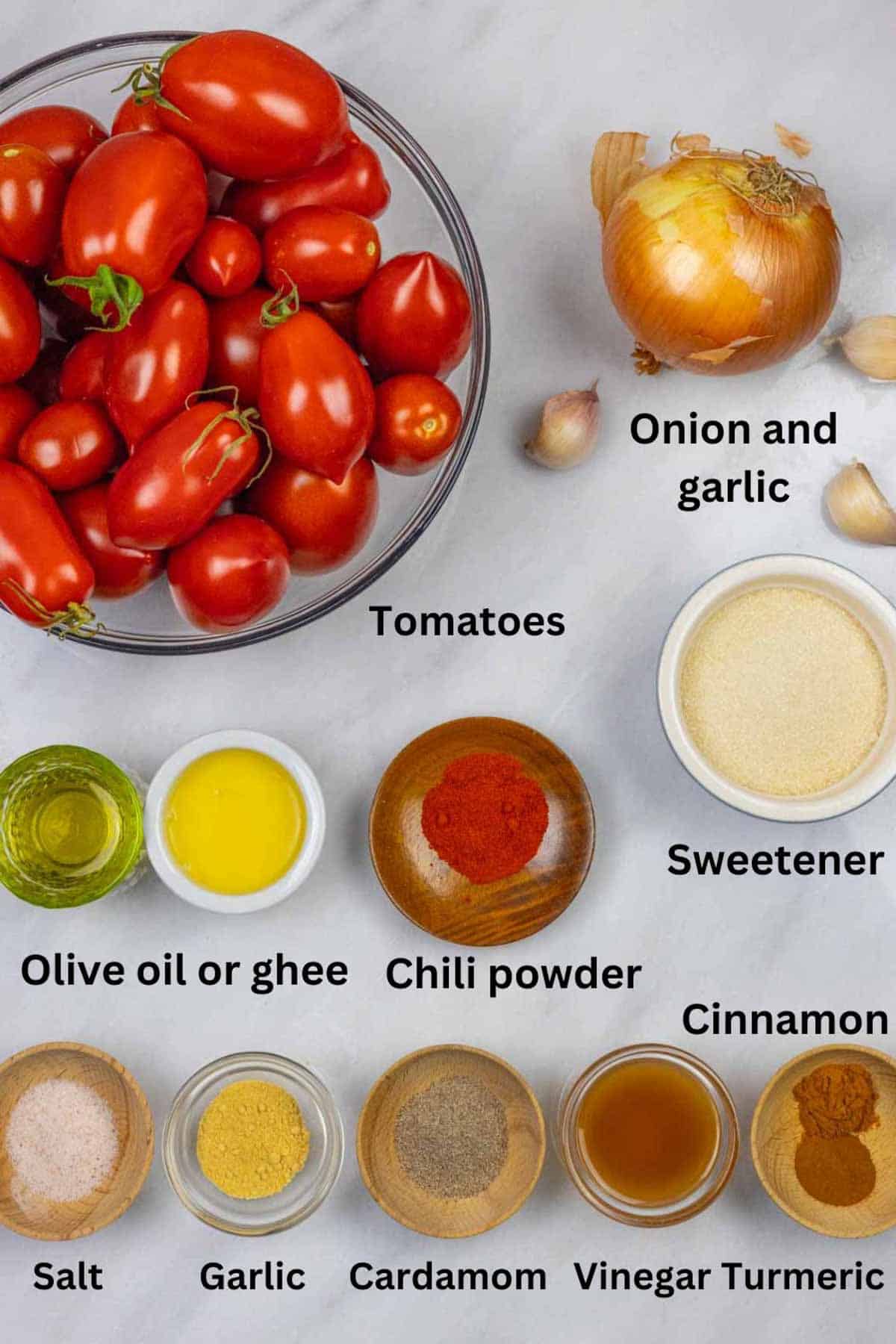
Ingredients
For the chutney
- Tomatoes – the star of the recipe. Use any variety you wish. And, with my instructions, there’s no need to peel your tomatoes.
- Onion – I like to use yellow onion but red or white can be used. See more about whether onions are low-FODMAP in the FAQ below.
- Garlic – three cloves add just enough flavor and aroma without being overpowering. Omit for low-FODMAP and consider using garlic scapes or garlic infused olive oil.
- Sweetener of choice – use regular sugar, stevia or allulose. Do not use erythritol, as it will crystalize when cooled, causing a gritty crunch. For Whole30, use date paste to sweeten.
- Olive oil or ghee – use either or both. I like to use ghee for sautéing the onion and garlic in the chutney and oil to make the tempering.
- Vinegar – apple cider vinegar is best but red or white wine vinegar can also be used
- Chili powder – my favorite is Kashmiri pepper, like I use in my Tikka Masala Powder and Tikka Masala Paste. It’s unique flavor and color is simply marvelous. You can also use domestic chili or even chipotle for a smoky touch.
- Ginger powder – adds a bright flavor. Use powder or a 1 inch piece of finely chopped fresh ginger.
- Cardamom – is sweet, peppery and slightly pungent
- Cinnamon – adds a sweet, spicy, woody aromatic flavor and aroma
- Turmeric – earthy, slightly bitter with hints of citrus and pepper
- Salt – brings the flavors together
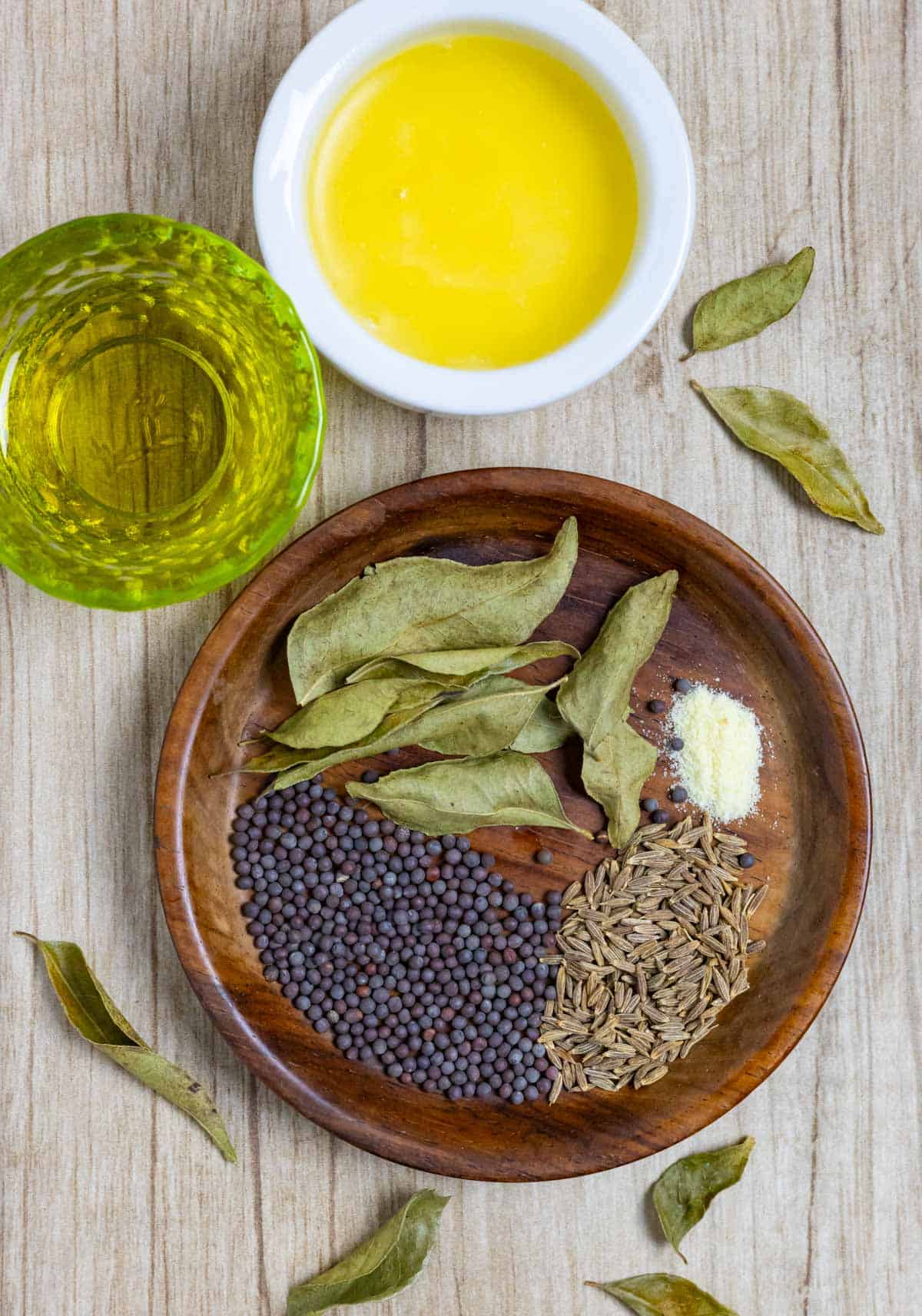
For the tempering (optional)
Tempering isn’t necessary, but enhances the flavors of the chutney (read more about tempering, below). Add this just before serving. If you don’t have all of the herbs and spices, you can use just one.
- Olive oil or ghee – either work well for high heat cooking. You can also use your favorite oil for cooking over high heat such as coconut or avocado oil.
- Curry leaves – these have a very complex flavor that’s both savory and citrusy. Read more in my Curry Leaves Ingredient Spotlight.
- Black mustard seeds – these can range from slightly spicy to slightly bitter and pungent. These pair extremely well with curry leaves.
- Cumin seeds (optional) – when toasted, these develop a deep, earthy, nutty and slightly smoky flavor
- Asafoetida (optional) – has a complex flavor, similar to onion and garlic. Read more in my Asafoetida Ingredient Spotlight.
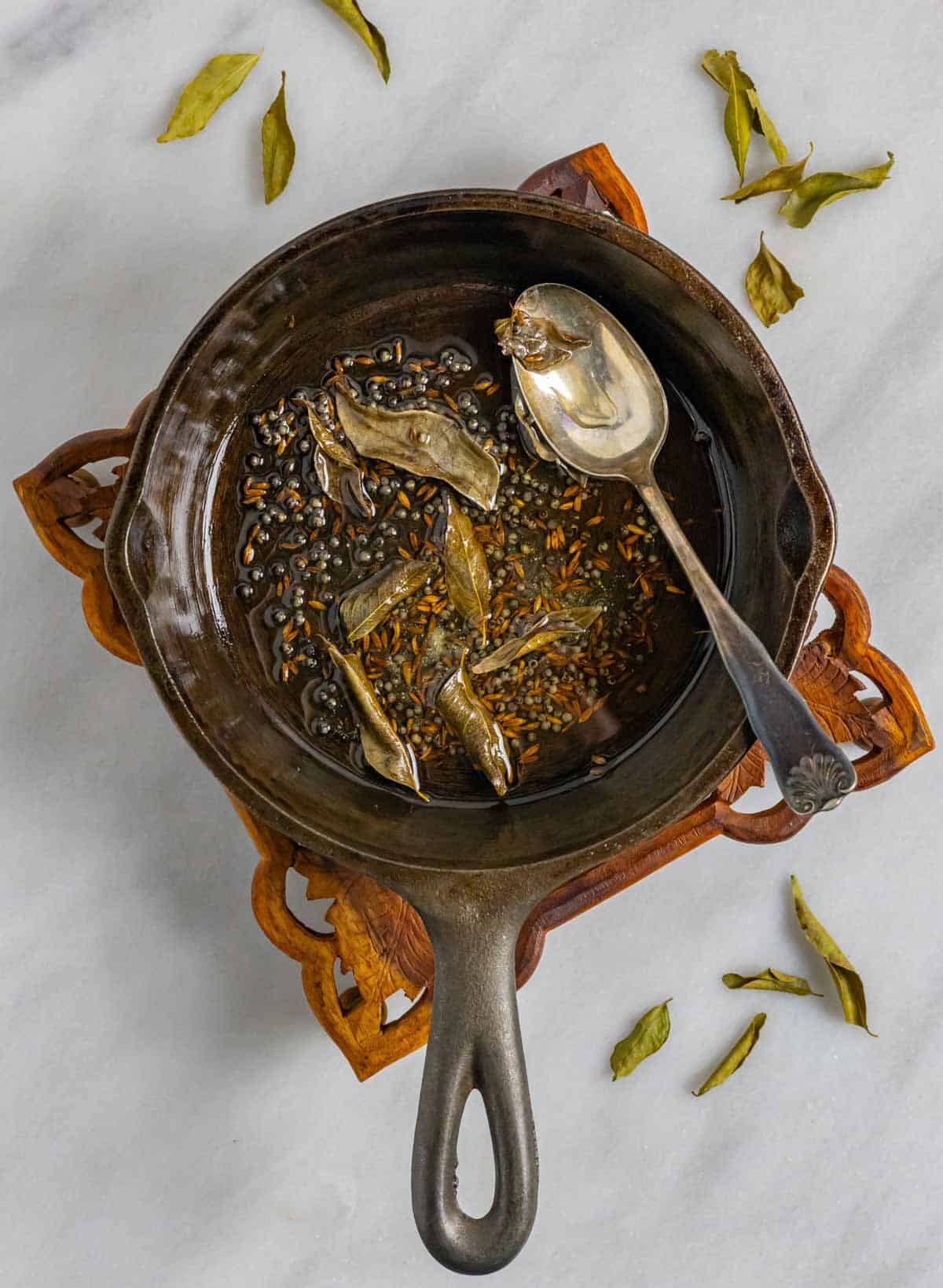
What is tempering?
Tempering (also known as ‘tadka’) is a technique used in Indian cuisine that is a method of extracting flavor from whole spices by heating them in hot oil or ghee, enhancing the finished dish. Once the flavor and aroma is extracted, the spiced, infused oil can be added to the dish either at the beginning of cooking or at the end, just before serving, depending on the recipe.
Instructions
To make the chutney
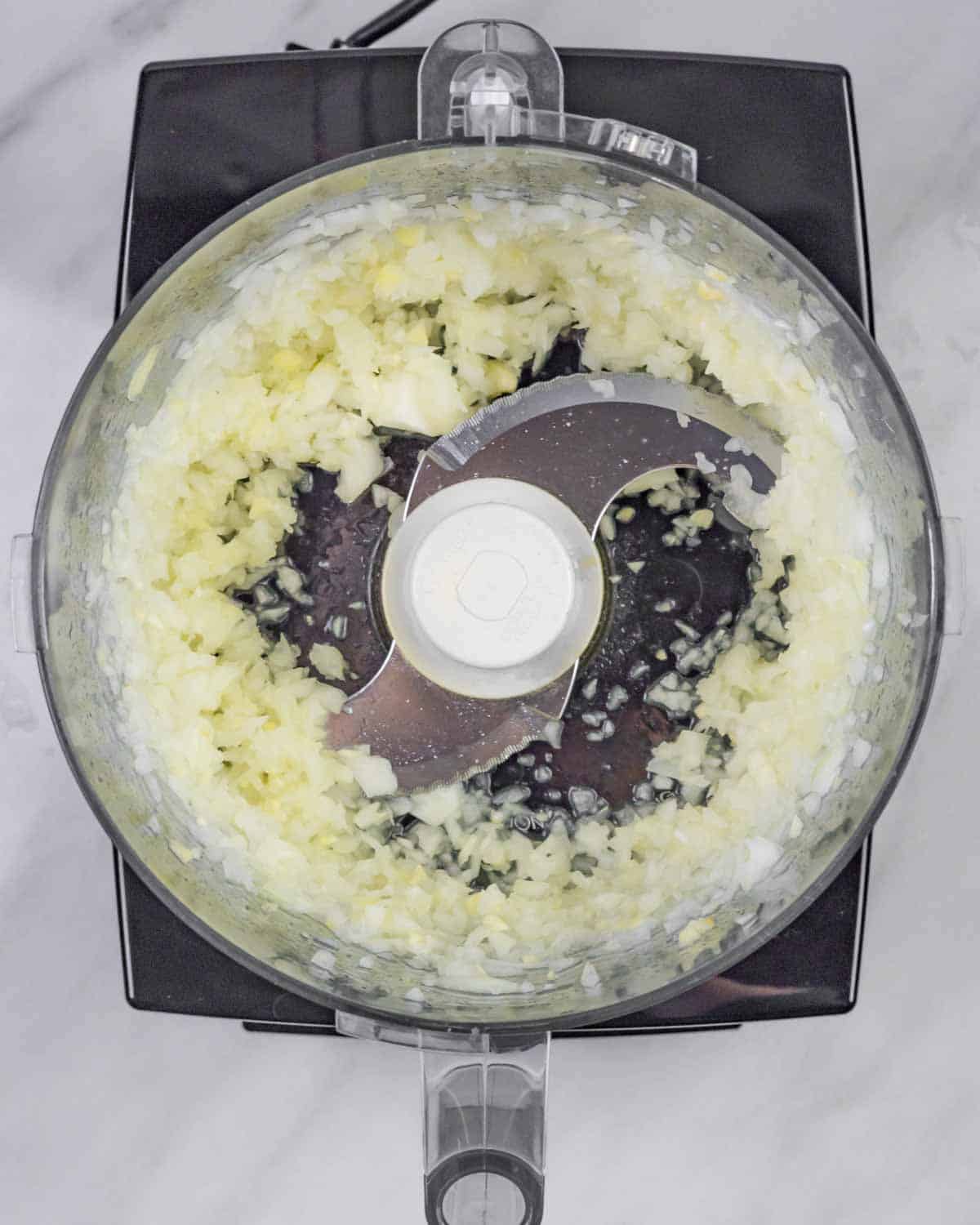
- Cut the onion into quarters or large chunks and place in your food processor
- Process into small pieces
If you don’t have a food processor, finely chop by hand.
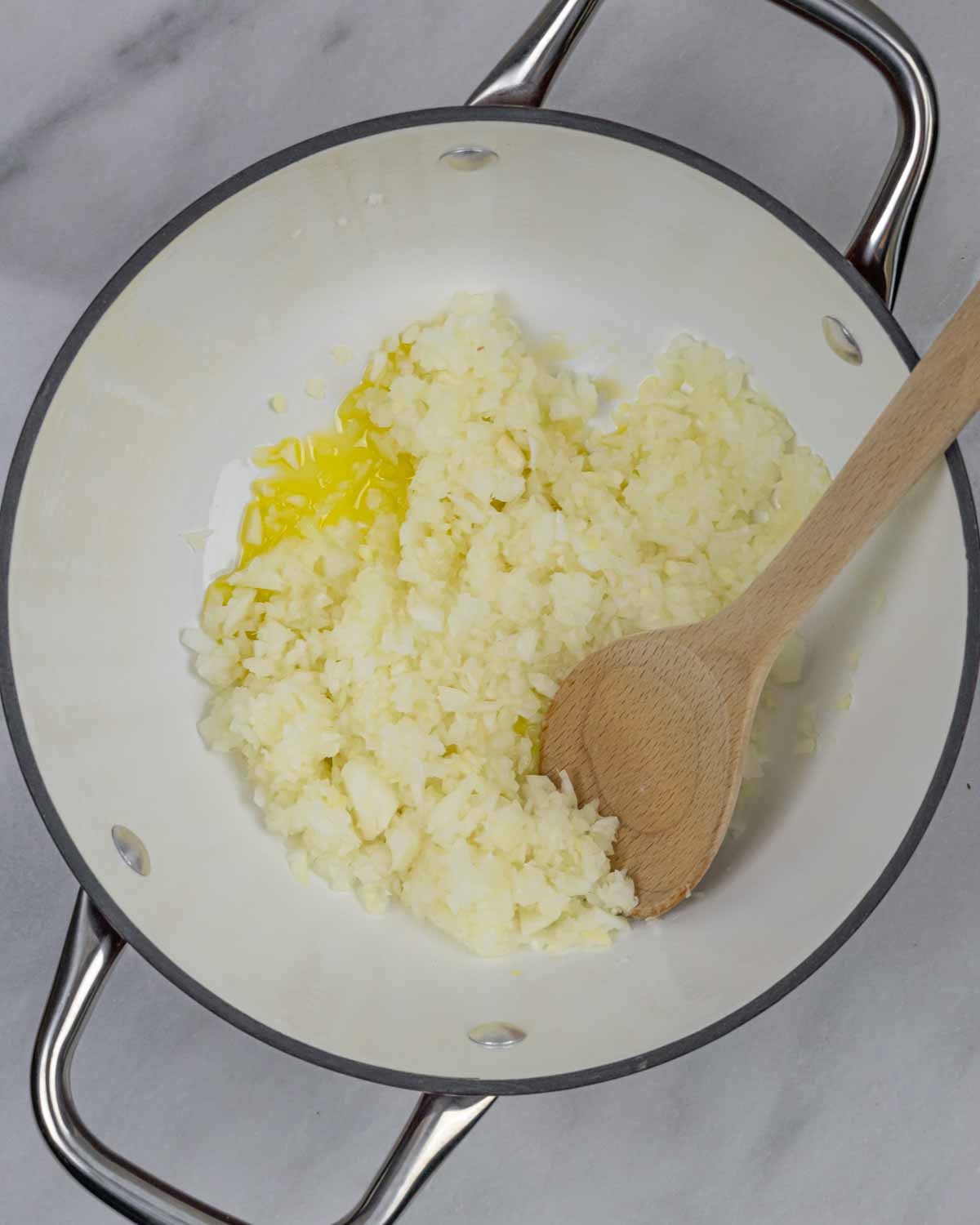
- Place 2 tablespoons of olive oil or ghee into a medium sauce pan and add the onion
- Sauté on medium heat until slightly softened
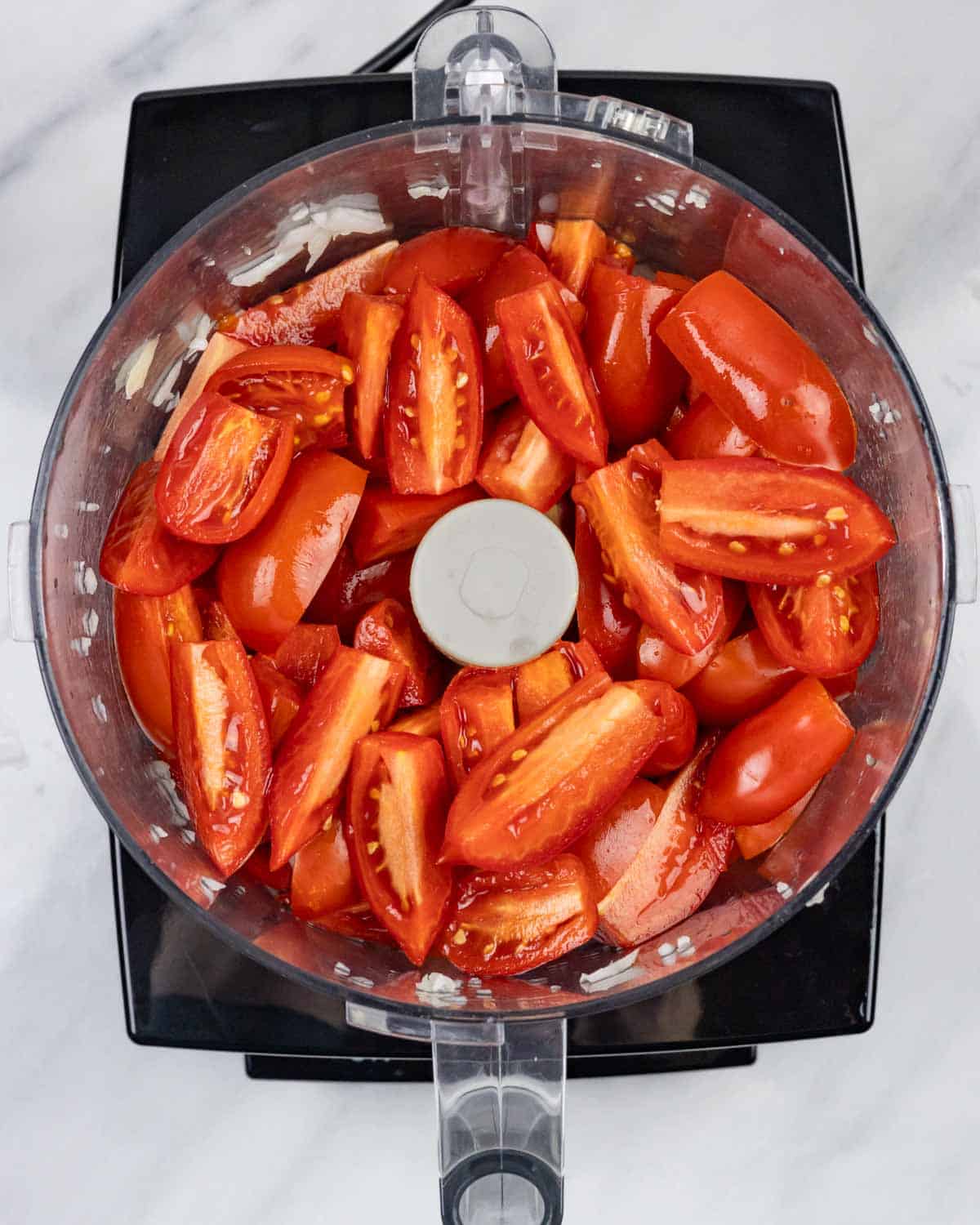
- Rinse the tomatoes and remove the stems and leaves
- Cut into large wedges and add to the food processor
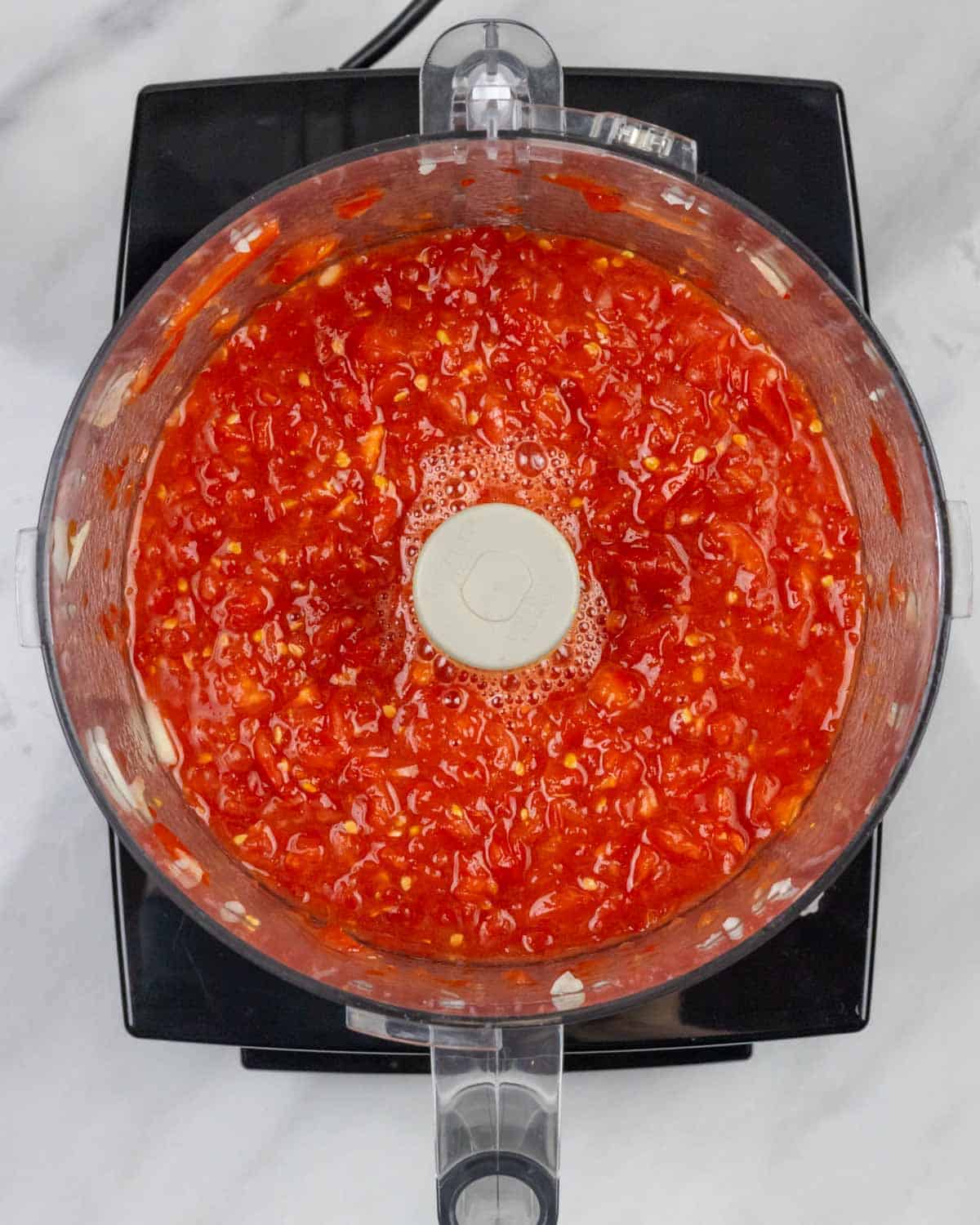
Process until you get a thick and chunky consistency, but not completely pureed.
If not using a food processor, you can use a blender or finely chop the tomatoes by hand.
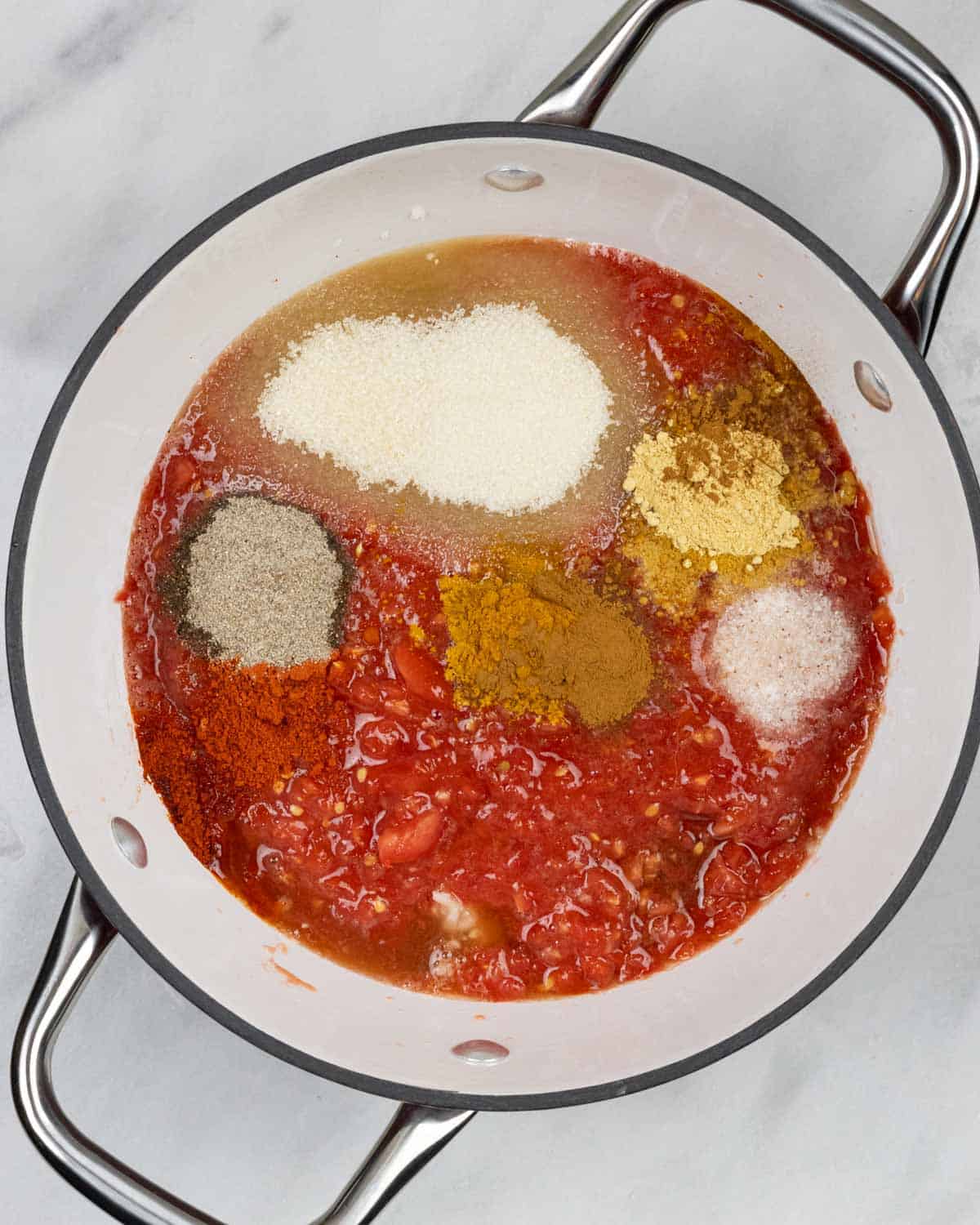
Add the tomatoes, sweetener, salt, vinegar and spices to the pot with the onions and garlic and stir until combined.
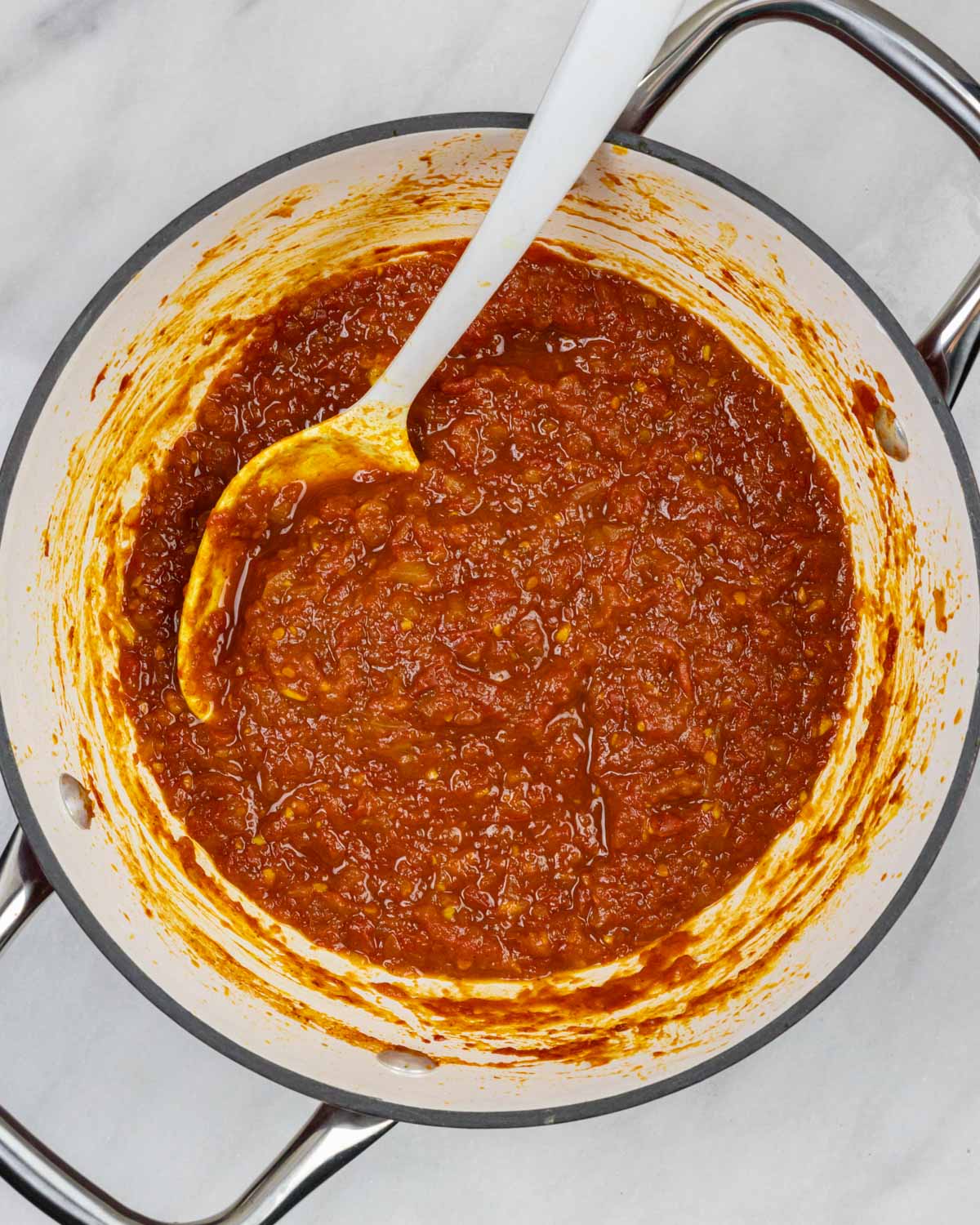
- Simmer on medium-low heat until very thick, about 45-60 minutes, stirring often. I like to partially cover the pot to prevent any splatter. As the mixture thickens, you will need to stir very often, every few seconds, to prevent burning.
- Turn off the heat and let cool. The chutney will continue to thicken as it cools.
Prepare the tempering
- Add 1 tablespoon of olive oil or ghee to a small pan and heat over medium heat until very hot
- Add the curry leaves, mustard seeds, asafoetida, and cumin seeds to the hot oil and toast for about 30 seconds or until very fragrant, stirring constantly to prevent burning
Expert tips
- Note that if chopping tomatoes by hand, you may notice some peels in the finished chutney. Consider peeling them before using. You’ll find complete instructions on how to peel and blanch tomatoes in my Pisto Manchego recipe.
- If you choose to use a blender, the tomatoes will be a smoother consistency. I recommend adding the sautéed onions and garlic and blending them with the tomatoes to create an even consistency.
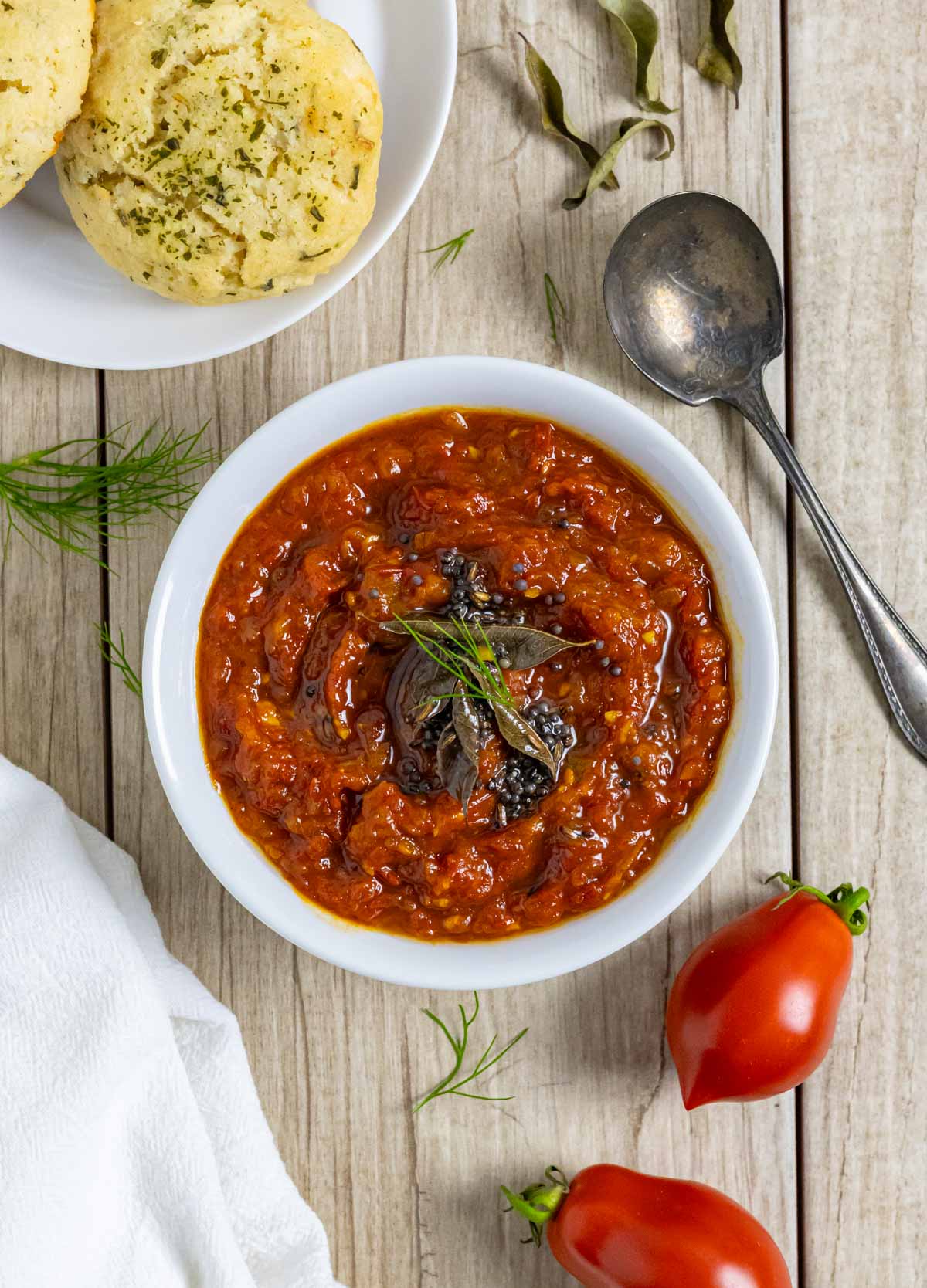
How to serve
Spoon the chutney into a serving dish, pour the tempering over the top and serve.
How to use
- As a savory condiment – spread on Cheddar Biscuits, top sandwiches or serve with meat or fish, like Air Fryer Halibut with Herbs and Citrus or savory Indian Spiced Salmon
- Dipping sauce – try dipping some crisp rutabaga or jicama fries – forget the ketchup!
- Add to eggs – spoon a dollop on any egg dish. Top boiled eggs, a scramble, omelets, or this Ham and Leek Frittata
- With steamed, grilled or roasted vegetables – this recipe pairs well with roasted rutabaga, broccoli or almost any fresh veggies
How to store
Store in a sealed container in the refrigerator for up to 7 days.
Variations and add-ins
- Shredded coconut – make a delicious coconut chutney by adding about ⅛ cup of shredded coconut
- Tamarind – add a small amount of tamarind paste for a delightful tang
- Use roasted garlic – replace the fresh garlic with roasted garlic for a deep, savory, nutty garlic flavor
- Use tikka or garam masala – if you don't have all of the spices, but have garam or tikka masala, you can use that spice blend in place of the individual spices. I like to use my homemade Tikka Masala Spice Blend or Tikka Masala Paste for an unforgettable flavor experience.
FAQ
Yes, absolutely – it freezes very well. Be sure to let it cool before transferring it to freezer-safe containers. I like to use small mason jars. It can be frozen for up to 6 months.
There are sweet, savory and spicy versions of chutney that have complex flavors. Salsas tend to be tart, zesty and can be served raw, like this Radish Salsa. Salsas also tend to include ingredients that are more coarsely chopped, where chutney is thick and has finely chopped or blended ingredients.
While chutneys are served throughout India, tomato chutney is also served in southern Indian cuisine. What it is served with will vary by region. For example, tomato chutney might be paired with samosas and pakoras in north India and paired with dosas and idlis in southern India.
Onions contain fructans that can cause digestive disturbances for some people. However, according to the Monash app, there are low-FODMAP serving sizes of onions. It’s generally recommended to avoid them during the elimination phase of the diet, as they tend to be a common trigger. Vidalia onions tend to have a lower fructan content and could be a great addition to this recipe. For a low-FODMAP tomato onion chutney, consider using half the onion and eliminate the garlic or use asafoetida and/or chopped leek (green part only) as an onion substitute. Read more about asafoetida in my Asafoetida Ingredient Spotlight.
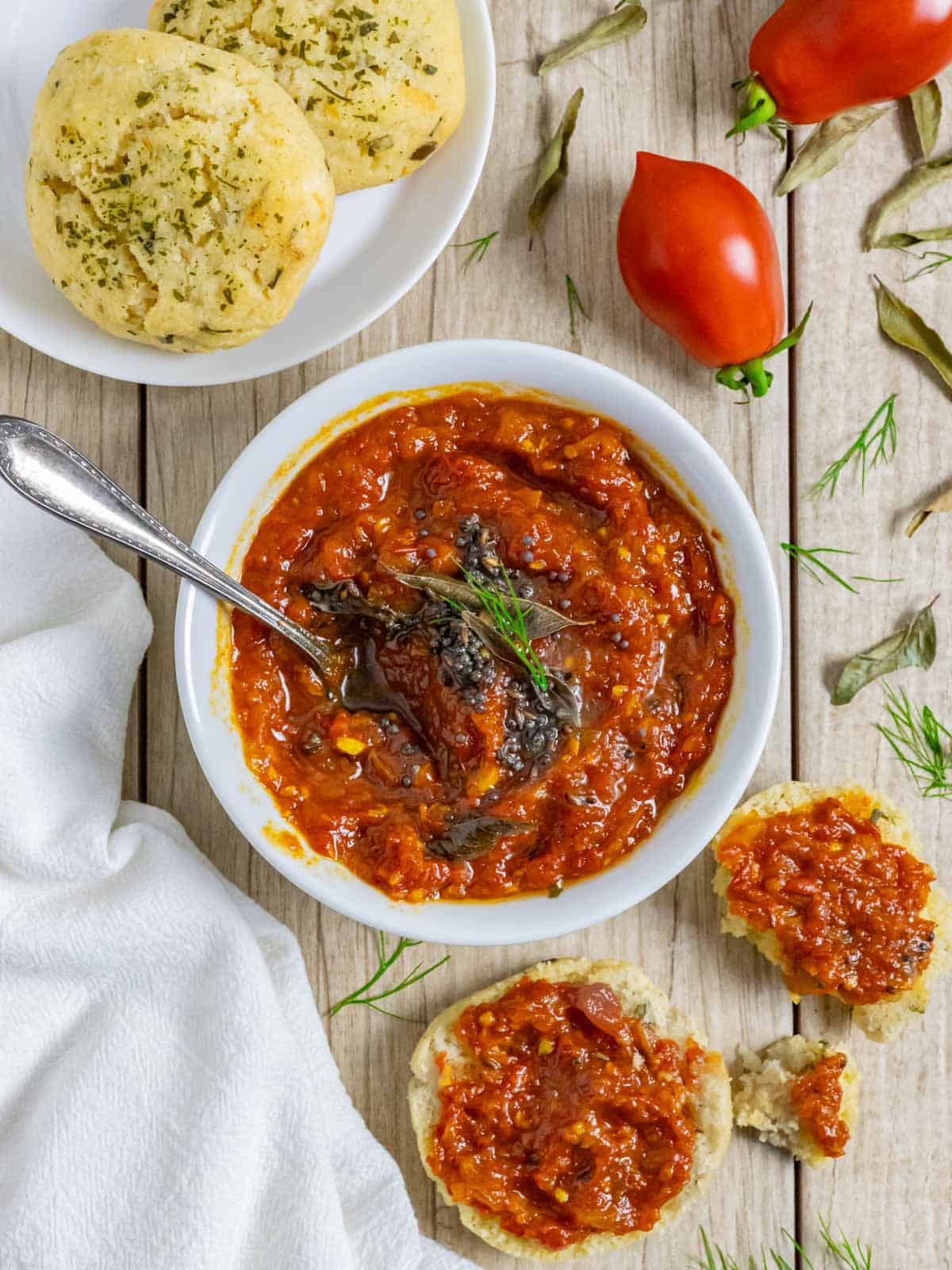
Did you make this recipe? Let me know how you liked it by giving a star rating and leaving a comment!
📖 Recipe
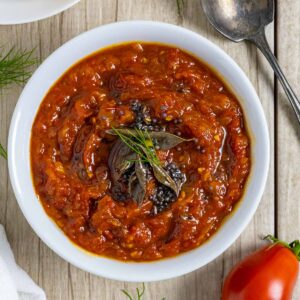
Tomato and Onion Chutney
Ingredients
Chutney ingredients
- 2 pounds tomatoes (any variety and size)
- 1 medium onion (any variety)
- ½ cup sweetener of choice (see Notes for recommendations)
- 2 tablespoons vinegar (apple cider vinegar or wine vinegar)
- 3 cloves garlic
- 2 tablespoons olive oil (or ghee)
- 1 teaspoon cardamom powder
- 1 teaspoon salt
- ½ teaspoon Kashmiri chili powder (red chili powder, or chipotle)
- 1 teaspoon ginger powder (or 1 inch fresh ginger - finely chopped)
- ½ teaspoon turmeric powder
- ¼ teaspoon cinnamon powder
Tempering ingredients (optional)
- 1 tablespoon olive oil (or ghee)
- 6 dried curry leaves (use 6-8 leaves, depending on size. Read more in my Curry Leaves Ingredient Spotlight.)
- ½ teaspoon black mustard seeds
- ½ teaspoon cumin seeds (optional)
- 1 pinch asafoetida powder (optional. Read more in my Asafoetida Ingredient Spotlight.)
Instructions
Chutney Instructions
- Cut the onion into quarters or large chunks and place in your food processor.
- Process into small pieces. If you don’t have a food processor, finely chop by hand.
- Add 2 tablespoons of olive oil or ghee into a medium sauce pan and add the onion.
- Sauté on medium heat until slightly softened.
- Rinse the tomatoes and remove the stems and leaves. Then cut into large wedges and add to the food processor.
- Process until you get a thick and chunky consistency, but not completely pureed. If not using a food processor, you can use a blender or finely chop the tomatoes by hand.
- Add the tomatoes, sweetener, salt, vinegar and spices to the pot with the onions and garlic and stir until combined.
- Simmer on medium-low heat until thick, about 45-60 minutes, stirring often. I like to partially cover the pot to prevent any splatter. As the mixture thickens, you will need to stir very often, every few seconds, to prevent burning.
- Turn off the heat and let cool. The chutney will thicken more as it cools.
Tempering instructions (see What is Tempering? in post)
- Add 1 tablespoon of olive oil or ghee to a small pan over medium heat until very hot.
- Add the curry leaves, mustard seeds, asafoetida and cumin seeds to the hot oil and toast for about 30 seconds or until very fragrant, stirring constantly to prevent burning.
Notes
Nutritional information is based on using alternative sweetener.
Selecting a sweetener
Use regular sugar, stevia or allulose. Do not use erythritol, as it will crystalize when cooled, causing a gritty crunch. For Whole30, use date paste 1:1 to replace the sweetener.Expert tips
- If chopping tomatoes by hand, you may notice some peels in the finished chutney. Consider peeling the tomatoes before using them. You’ll find complete instructions on how to peel and blanch tomatoes in my Pisto Manchego recipe.
- With a blender, the tomatoes will be a smoother consistency. I recommend blending the sautéed onions and garlic with the tomatoes to create an even consistency.
Nutrition
*Net carbs = carbohydrates - fiber
Nutritional information is an estimate, calculated using online tools and does not include optional ingredients unless otherwise indicated.

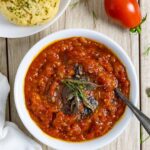

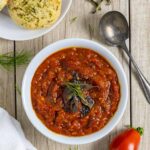
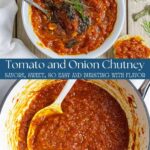
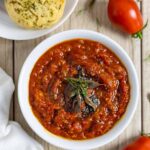
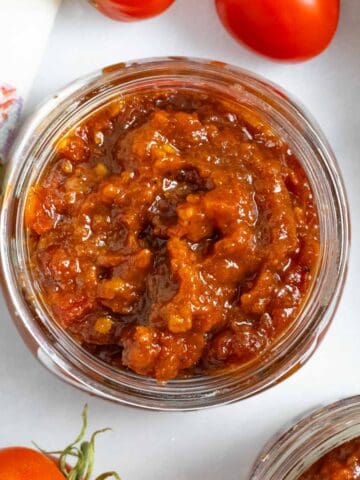
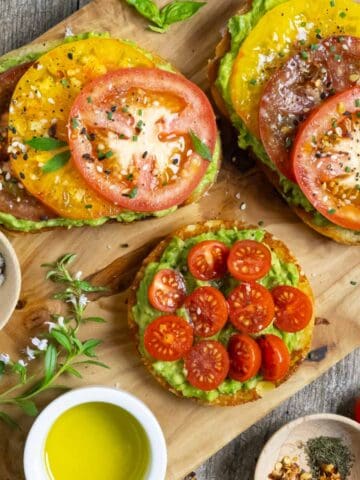

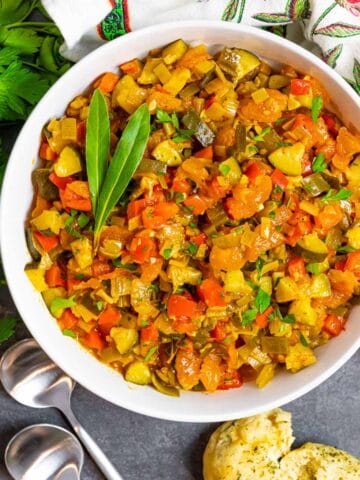
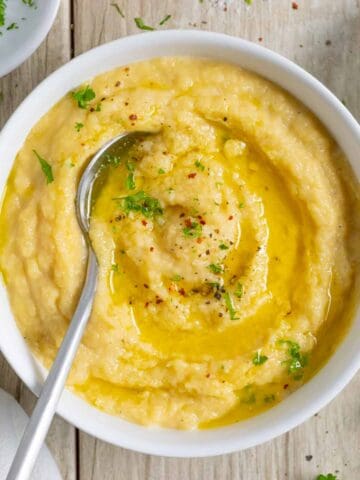
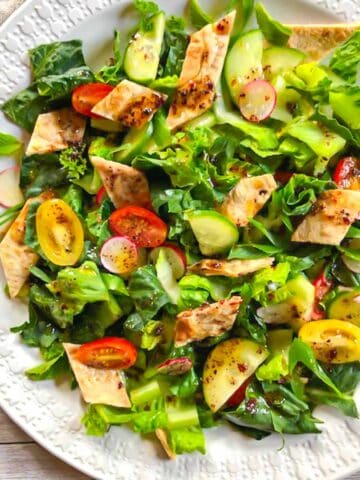
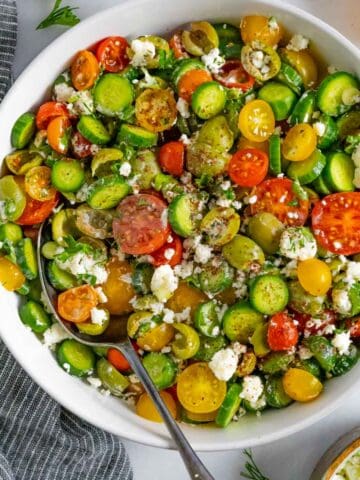
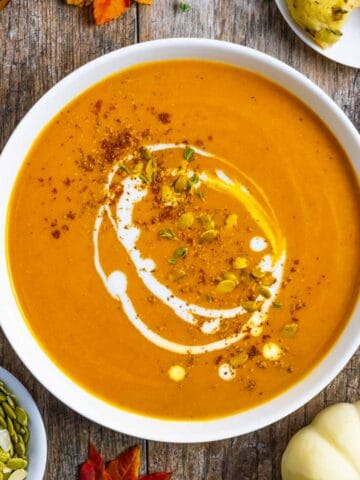
Comments
No Comments